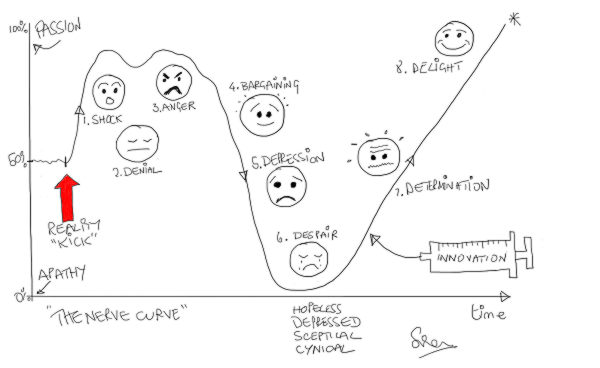 The emotional journey of change feels like a roller-coaster ride and if we draw as an emotion versus time chart it looks like the diagram above.
The emotional journey of change feels like a roller-coaster ride and if we draw as an emotion versus time chart it looks like the diagram above.
The toughest part is getting past the low point called the Well of Despair and doing that requires a combination of inner strength and external support.
The external support comes from an experienced practitioner who has been through it … and survived … and has the benefit of experience and hindsight.
The Improvement Science coach.
What happens as we apply the IS principles, techniques and tools that we have diligently practiced and rehearsed? We discover that … they work! And all the fence-sitters and the skeptics see it too.
We start to turn the corner and what we feel next is that the back pressure of resistance falls a bit. It does not go away, it just gets less.
And that means that the next test of change is a bit easier and we start to add more evidence that the science of improvement does indeed work and moreover it is a skill we can learn, demonstrate and teach.
We have now turned the corner of disbelief and have started the long, slow, tough climb through mediocrity to excellence.
This is also a time of risks and there are several to be aware of:
- The objective evidence that dramatic improvements in safety, flow, quality and productivity are indeed possible and that the skills can be learned will trigger those most threatened by the change to fight harder to defend their disproved rhetoric. And do not underestimate how angry and nasty they can get!
- We can too easily become complacent and believe that the rest will follow easily. It doesn’t. We may have nailed some of the easier niggles to be sure … but there are much more challenging ones ahead. The climb to excellence is a steep learning curve … all the way. But the rewards get bigger and bigger as we progress so it is worth it.
- We risk over-estimating our capability and then attempting to take on the tougher improvement assignments without the necessary training, practice, rehearsal and support. If we do that we will crash and burn. It is like a game of snakes and ladders. Our IS coach is there to help us up the ladders and to point out where the slippery snakes are lurking.
So before embarking on this journey be sure to find a competent IS coach.
They are easy to identify because they will have a portfolio of case studies that they have done themselves. They have the evidence of successful outcomes and that they can walk-the-talk.
And avoid anyone who talks-the-walk but does not have a portfolio of evidence of their own competence. Their Siren song will lure you towards the submerged Rocks of Disappointment and they will disappear like morning mist when you need them most – when it comes to the toughest part – turning the corner. You will be abandoned and fall into the Well of Despair.
So ask your IS coach for credentials, case studies and testimonials and check them out.
